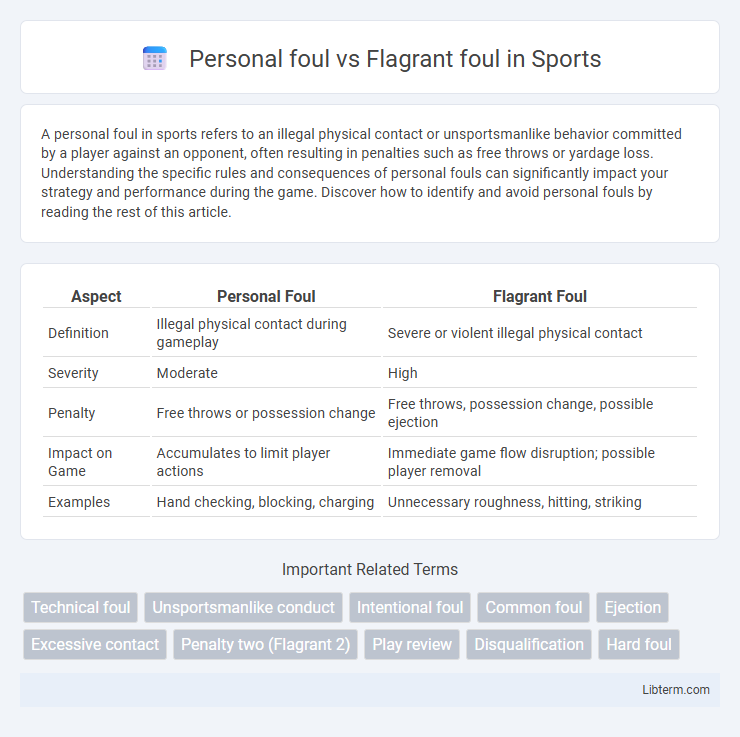A personal foul in sports refers to an illegal physical contact or unsportsmanlike behavior committed by a player against an opponent, often resulting in penalties such as free throws or yardage loss. Understanding the specific rules and consequences of personal fouls can significantly impact your strategy and performance during the game. Discover how to identify and avoid personal fouls by reading the rest of this article.
Table of Comparison
| Aspect | Personal Foul | Flagrant Foul |
|---|---|---|
| Definition | Illegal physical contact during gameplay | Severe or violent illegal physical contact |
| Severity | Moderate | High |
| Penalty | Free throws or possession change | Free throws, possession change, possible ejection |
| Impact on Game | Accumulates to limit player actions | Immediate game flow disruption; possible player removal |
| Examples | Hand checking, blocking, charging | Unnecessary roughness, hitting, striking |
Understanding Personal Fouls: Definition and Basics
Personal fouls occur when a player makes illegal physical contact with an opponent during play, such as hitting, pushing, or holding. These fouls are common in basketball and result in free throws or possession changes depending on the team's foul count. Understanding the basics of personal fouls is essential for players and coaches to maintain fair play and avoid penalties.
What Constitutes a Flagrant Foul?
A flagrant foul in basketball constitutes unnecessary or excessive contact that risks injury to an opponent, typically classified into Flagrant 1 and Flagrant 2 categories based on severity. Unlike a personal foul, which involves routine physical contact during play, a flagrant foul includes actions deemed violent or dangerous, such as hitting, striking, or aggressively pushing an opponent. The NBA and NCAA rulebooks specify that referees must assess both the intent and impact of the contact to determine a flagrant foul, often leading to ejection or penalty shots.
Key Differences Between Personal and Flagrant Fouls
A personal foul in basketball involves illegal physical contact during regular play, typically resulting in free throws or possession changes when limits are exceeded. A flagrant foul is more severe, indicating excessive or violent contact that endangers player safety and often leads to ejections and fines. Key differences include the intent and severity of contact, with flagrant fouls carrying harsher penalties due to their dangerous nature.
The Impact of Personal Fouls on Gameplay
Personal fouls in basketball affect gameplay by limiting a player's time on the court and increasing the opposing team's scoring opportunities through free throws. Accumulating multiple personal fouls can lead to a player's disqualification, reducing team strength and altering defensive strategies. These fouls often result from routine physical contact, differing from flagrant fouls which involve excessive or violent conduct, causing greater game disruption and potential ejections.
When Does a Foul Become Flagrant?
A foul becomes flagrant when it involves excessive or violent contact that risks injury to an opponent, exceeding the intensity of a personal foul. Referees assess the severity, intent, and impact of the contact to determine if it meets the criteria for a flagrant foul, which usually results in harsher penalties. Understanding the distinction helps maintain player safety and enforces sportsmanship in basketball.
Penalties for Personal vs Flagrant Fouls
Personal fouls in basketball typically result in free throws for the opposing team only after a certain team foul threshold is reached in a quarter, with the fouled player often awarded one or two free throws depending on the situation. Flagrant fouls carry harsher penalties, including two free throws and possession of the ball for the opposing team, along with potential fines or suspensions for severe or repeated infractions. The severity of flagrant fouls reflects their intent and danger, distinguishing them from personal fouls which are generally less punitive and more common during gameplay.
Common Examples of Personal Fouls
Common examples of personal fouls in basketball include illegal hand-checking, blocking, holding, and reaching in. These infractions typically involve minor physical contact that impedes an opponent's movement or ability to control the ball. Personal fouls differ from flagrant fouls, which involve excessive or violent contact intended to injure or intimidate an opponent.
Notorious Flagrant Fouls in Basketball History
Personal fouls in basketball are common infractions involving illegal physical contact, while flagrant fouls are severe violations characterized by excessive or violent contact that endangers player safety. Notorious flagrant fouls in basketball history include Kermit Washington's 1977 punch on Rudy Tomjanovich, resulting in serious injury and a suspension, and Donaghy's 2007 flagrant foul during an NBA playoff game that sparked significant controversy. These incidents highlight the impact of flagrant fouls on game integrity and player health, often leading to stricter enforcement and harsher penalties.
How Referees Judge Foul Severity
Referees judge personal fouls based on factors such as contact location, player intent, and impact on play, typically calling routine infractions that involve illegal physical contact without excessive aggression. Flagrant fouls are assessed by evaluating the severity of the contact, including the risk of injury and unsportsmanlike conduct, with referees considering whether the foul was unnecessary or excessively forceful. Video reviews and player reactions often assist referees in distinguishing between minor personal fouls and severe flagrant fouls to ensure appropriate penalties.
Reducing Fouls: Sportsmanship and Player Safety
Personal fouls primarily involve minor physical contact violations often resulting in free throws or possession changes, while flagrant fouls signify severe or intentional physical harm, warranting harsher penalties like ejections. Emphasizing sportsmanship and player safety, coaches implement disciplined training to minimize aggressive behaviors that lead to flagrant fouls, fostering respectful competition. Rule enforcement and player education on legal contact reduce overall fouls and enhance safe gameplay environments in basketball and similar sports.
Personal foul Infographic

 libterm.com
libterm.com